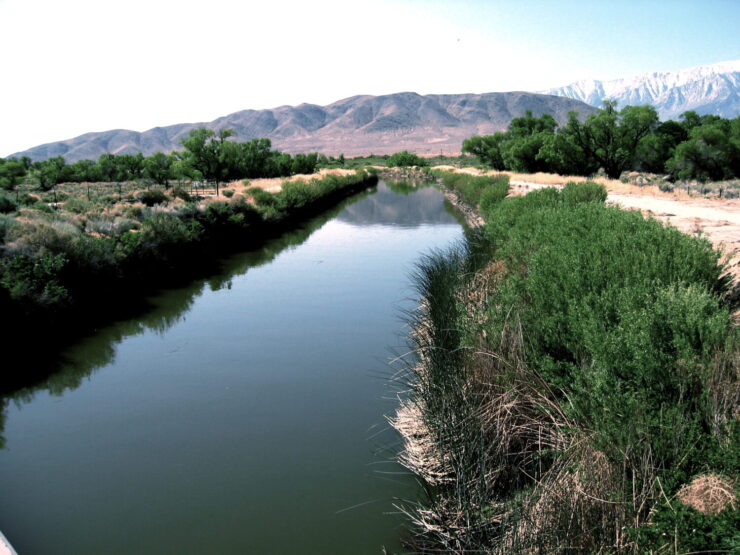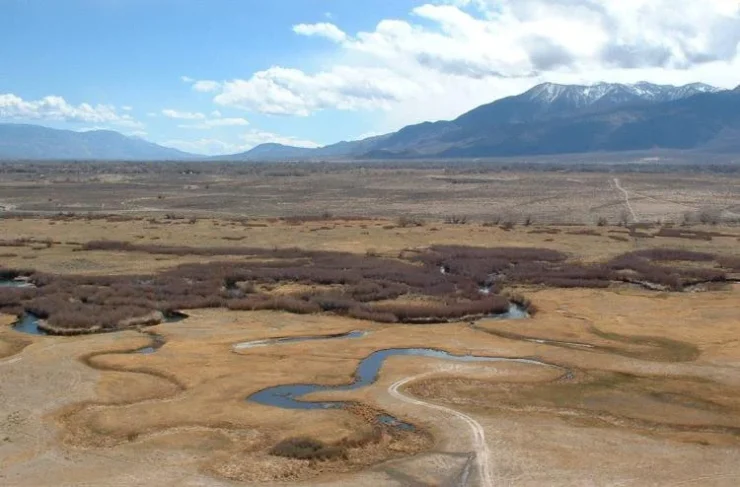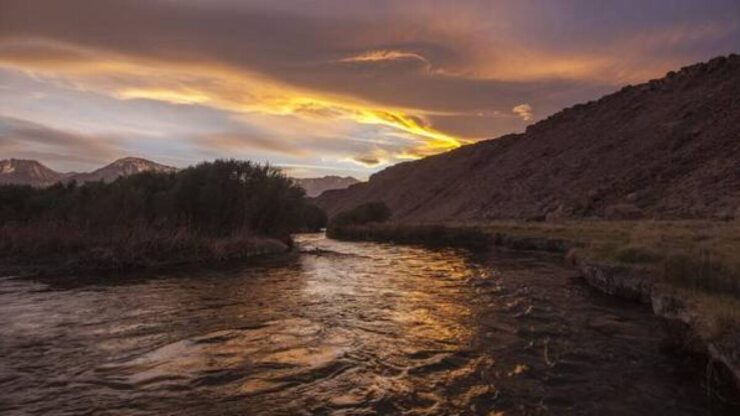Note: In 2008, Inyo County Water Department posted a far more extensive 1902-2007 chronology of events in Owens Valley water history than our overview. If you’d like to see it, click here:
In 1902, to open more western land to settlement and irrigation, Congress created the United States Reclamation Service. The Owens Valley in eastern California was one of the first places considered for a government-sponsored irrigation system.
Simultaneously, however, William Mulholland, Los Angeles superintendent of water, took note of the quality, quantity, and proximity of Owens Valley water. Well aware that more water was necessary for Los Angeles’ growth, Mulholland and others garnered political and economic support for a Los Angeles water project by implying in speeches, interviews, and articles that Los Angeles teetered on the brink of a water crisis.

Letting Owens Valley ranchers and farmers believe they were selling their land to the U.S. Reclamation Service for the Owens Valley irrigation project, engineers J.B. Lippincott and Fred Eaton bought vast amounts of land and associated water rights in the valley for the Los Angeles Department of Water and Power (LADWP).
The Reclamation Service then scuttled the irrigation project. Instead of returning reclamation service land in the Owens Valley to the public domain for homesteading, Forest Service chief Gifford Pinchot–with the encouragement of President Teddy Roosevelt– made reclamation land (mostly treeless) a part of the Inyo National Forest under the auspices of “the greatest good for the greatest number.”
In spite of protests from valley farmers and ranchers, Los Angeles completed the first aqueduct from the valley to Los Angeles in 1913 and filled it with reductions in irrigation and, more effectively, by diverting the lower Owens River to the aqueduct. LADWP continued to acquire land and water rights as valley farmers gave up their dead and dying crops and orchards and moved.
By 1924, Owens Lake and approximately fifty miles of the Owens River were dry. By the 1930s, Los Angeles owned approximately 95 percent of all farm and ranch land in the valley.
In April 1937, Congress passed an Act that authorized the exchange of lands occupied by Native Americans with LADWP-owned lands near Lone Pine, Bishop, and Big Pine (resulting in the Land Exchange Agreement of 1939) and that established the Bishop, Big Pine, and Lone Pine Paiute-Shoshone Indian Reservations. Although Los Angeles agreed to supply a set amount of water to the reservations, the land exchange did not include water rights.
In 1940, LADWP completed construction on an 11-mile underground tunnel connecting Mono Basin with the Owens River in Long Valley. In 1940, Los Angeles and landowners in the Bishop area also ended a court battle over LADWP’S groundwater pumping in and around Bishop with the “Hillside Decree,” which stipulated that Los Angeles could not pump and export groundwater from an area surrounding Bishop that was labeled the “Bishop Cone.”
In 1963, LADWP approved plans for a second aqueduct with a capacity of 300 cubic feet per second, bringing the total proposed aqueduct capacity to 780 cubic feet per second. The aqueduct was completed in 1970.
In late 1970, however, California legislators passed the California Environmental Quality Act, which, among other measures, required agencies to at least consider environmental consequences of their actions in the form of an Environmental Impact Report (EIR). In 1972, when Los Angeles announced that the City would fill the second aqueduct with increases in Owens Valley groundwater pumping, decreases in Owens Valley irrigation, and more exported water from the Mono Basin, Inyo County turned to its new–and possibly only–legal recourse and sued LADWP to force the agency to file an EIR.
LADWP responded by installing water meters in residences and threatening to cut off water to agricultural and recreational lessees. In court, Los Angeles claimed it didn’t have to provide an EIR because it had completed the aqueduct before the California Environmental Quality Act was passed, but Inyo County argued successfully that supplying water with permanent changes in groundwater pumping and irrigation was a separate action from building the aqueduct. Foiled, Los Angeles completed two EIRs, one in 1976 and a second in 1979. Both reports were rejected as inadequate by the courts.
Meanwhile, Los Angeles continued to pump groundwater. Wetland meadows, seeps, springs, and marshes dried and disappeared, well water levels dropped, and vegetation in the valley began to change. Dust storms increased. In 1980 Inyo County voters passed an ordinance to regulate groundwater pumping in the valley through a groundwater management plan. Los Angeles sued, and Inyo was directed in May 1981 not to implement the ordinance. In July 1983 the ordinance was ruled unconstitutional by a superior court, although it was within Inyo County’s rights to appeal the ruling.

In 1982, the Inyo County Board of Supervisors began closed meetings with LADWP to develop a groundwater management plan. Under the terms of the agreement, Inyo and the DWP would work together for five years on a joint management plan, Inyo would temporarily drop its groundwater ordinance lawsuit and its opposition to the second EIR, and Los Angeles would continue to pump groundwater. If Inyo and Los Angeles failed to agree on groundwater pumping, Los Angeles would resort to a pumping table that allowed the city to take three times as much water as the county had recommended in its own management plans.
No enforcement measures for the agreement were proposed, and recommendations of a citizen’s advisory committee to the Inyo Water Commission were ignored. The terms of the agreement were drafted in a series of meetings closed to the public and then presented to Owens Valley residents shortly before the agreement was to be ratified.
Faced with an agreement with no legal teeth and no limits on pumping, members of the citizen’s advisory committee and other concerned residents of Owens Valley –including Bill and Barbara Manning, Mary DeDecker, Vince Yoder, David Miller, Michael Prather, Father Christopher Kelley, and Kenny Scruggs–formed the Owens Valley Committee (OVC) in late 1983.
The committee incorporated in early 1984 to avoid lawsuits against individuals. The first actions of OVC representatives (there were no official members) included publishing educational pamphlets dissecting the agreement, appearing and speaking at public meetings, conducting telephone surveys, writing letters to local newspapers, and publishing TV, radio, and newspaper ads about the 5-year water agreement and conditions in the Owens Valley.
When Inyo County and Los Angeles signed the agreement in spite of 1) the OVC’s objections, 2) opposition from other organizations, and 3) rampant public disapproval, the Owens Valley Committee sued to stay implementation of the water agreement until an adequate Environmental Impact Report had been filed. This suit was rejected by the Superior Court. The OVC and the Sierra Club Legal Defense fund then filed a friend of the court (amicus curaie) brief with the Third District Court of Appeals in Sacramento.
In 1985, the appeals court approved the five-year water management agreement, but did not accept Inyo’s and Los Angeles’ argument that it should substitute for an EIR. Instead, Los Angeles was directed to present a new management plan and an adequate EIR by February 1989, at the end of the joint management plan development period.
From 1985 to 1990, LADWP and Inyo County developed a long-term joint groundwater management plan and began work on a draft EIR. The OVC continued to evaluate developing plans, to scrutinize LADWP actions in the valley, and to educate the public. After delays and deadline extensions from the appeals court, a draft EIR was released for public comment in 1990.
Again, the OVC encouraged public commentary. A long-term drought encouraged even more public commentary. The OVC supported the long-term agreement, but it did not support the EIR, noting, among other problems, an inadequate description of the valley environment prior to 1970, an inadequate description of 1970-1990 environmental impacts, and an inadequate drought recovery policy.
Meanwhile, in a protest over the water agreement, Inyo County residents began a drive for a recall election for Inyo County Supervisors. OVC took a position against the recall and supported the water agreement, noting that although the agreement would need some modifications, it was still a step forward in water management for the Owens Valley.
In late 1991, Inyo and Los Angeles signed a long-term water agreement and submitted a “final” EIR to the appeals court, in spite of objections to the EIR. Owens Lake pollution was not mentioned in this EIR or in the agreement because the Great Basin Air Pollution Control District was negotiating a separate agreement on dust abatement with LADWP.
The Third Court of Appeals invited friend of the court briefs from several organizations, including the OVC and Carla Scheidlinger, the California Department of Fish and Game, the California State Lands Commission, and the Sierra Club. The court also strongly invited these organizations to pursue settlement discussions outside of court before filing a brief.
Deadline extensions and negotiations ensued. Although OVC and other involved parties supported the agreement between Inyo and LADWP, doubts about the EIR persisted. The California Department of Fish and Game and LADWP could not agree on EIR rewatering conditions for the Lower Owens River Project, and out-of-court settlement talks ended in 1993. From 1993 to 1997, a series of negotiations and studies, including a study of the effects of rewatering parts of the lower Owens River, resulted in a June 1997 Memorandum of Understanding (MOU) between Inyo, LADWP, the OVC, Carla Scheidlinger, the Sierra Club, the California Department of Fish and Game, and the California State Lands Commission.
The MOU outlined a number of required studies and mitigation projects, including:
- The Lower Owens River Project. A 62-mile stretch of the lower Owens River was to be rewatered, including an average of 6-9 cubic feet per second of water supplied to the Owens River delta at the north end of Owens Lake. Off-river lakes and ponds were to be maintained or restored, and an area near Blackrock Springs was to be flooded to provide habitat for resident and migratory waterfowl.
- An evaluation of Yellow-Billed Cuckoo habitat at Hogback and Baker creeks.
- An aerial photo analysis of vegetation.
- An inventory of flora and fauna at springs and seeps.
- Control of salt cedar (an invasive exotic).
- Development of management plans for riparian and other sensitive habitats.
A key element of the MOU provided for the formation of a Steering Committee with a representative from each party to the MOU. The Steering Committee– which includes a representative of the Owens Valley Committee — consults on all aspects of the MOU.
The 1997 MOU did not, however, include enforcement measures.
As a 2000 deadline for a Draft Environmental Impact Report (DEIR) for the Lower Owens River Project (LORP) came and went, MOU parties agreed on several time extensions for the DEIR (which, due to a grant of federal funds for the project, was also by that time a Draft Environmental Impact Statement, or DEIR/S).
In December 2001, after the expiration of the most recent extension of the deadline to complete the DEIR/S, the Owens Valley Committee and the Sierra Club joined in litigation to compel Los Angeles and Inyo County to complete the draft document so that mitigation for damage from previous groundwater pumping could commence.
As part of its reasoning for delays, Los Angeles noted that it had planned for a pumpback station with 150 cubic feet per second (c.f.s.) capacity at the southern end of the newly rewatered river, above the Delta, to return water to the Los Angeles Aqueduct before that water reached the lake. Two sets of plans–one for this station and one set for a 50 c.f.s. station as originally specified in the Long Term Water Agreement–required significant additions to the DEIR/S.
In response, other MOU parties contended that the Long Term Water Agreement specified a pump station that would have no greater capacity than 50 cubic feet per second, and that the MOU had not changed this capacity. Among the objections residents in the valley raised to a larger pumpback station was the problem that, with a larger pumpback station, Los Angeles would be able to create new groundwater pumping wells and use the newly rewatered river to transport the increased flows, thus transforming the Lower Owens River mitigation project for groundwater pumping damage into another means to export groundwater.
All MOU parties agreed to a court stipulation that the Draft EIR/S would be released in August 2002. After the new deadline had passed with no DEIR/S, the Inyo County Superior Court ordered that a DEIR/S be released by November 2002, and it was. The DEIR/S included an option for the larger pumpback station.
The OVC and Sierra Club then filed amended complaints addressing, among other issues, the size of the pumpback station and non-compliance with the 1997 MOU. In late 2003, the California Department of Fish and Game filed a cross complaint in the case. A 2004 order from the Inyo County Superior Court stipulated that LADWP would build a 50 c.f.s. pump station, release a Final Environmental Impact Report/Statement for the LORP by June 2004, begin rewatering the river by September 2005, provide matching funds for a salt cedar control program, and complete work plans for the Hines Spring and yellow-billed cuckoo habitat mitigation programs.
LADWP completed an FEIR by the deadline, but disinvited the County and the EPA from the process approximately one month before producing the document. Although the document was also billed as an Environmental Impact Statement, the document did not met the EPA’s standards for an EIS and thus jeopardized federal grants for the Lower Owens River Project.
The Sierra Club noted in a fall 2004 lawsuit that the document also did not adequately address environmental impacts of the project on a transition area between the Owens River Delta and the Owens Lake, and a judge agreed with that observation in 2005. In 2005, the Owens Valley Committee and the Sierra Club also filed a complaint alleging, among other things, that the Lower Owens River Project as described in the FEIR would not meet the goals of the 1997 MOU.
Concurrently to lawsuits and negotiations over the implementation of the 1997 MOU, the Great Basin Unified Air Pollution Control District negotiated a Memorandum of Agreement (MOA) with LADWP that was approved by the Environmental Protection Agency in October 1999. The MOA required LADWP to control dust from the dry Owens Lake bed, beginning with ten square miles of dust control measures that were originally to be completed by the end of 2001 and were in fact completed in approximately 2006.
In November 2001, as part of these measures, LADWP officially began shallow flooding on a small portion of the Owens Lake bed. The MOA did not require Los Angeles to rewater the Owens Lake; however, it specified that LADWP must meet federal air quality standards by 2006, later modified to 2010, by using shallow flooding, managed vegetation, gravel, or other approved dust control measures. By early 2013, Los Angeles still had not met federal air quality standards on the lakebed.
It became clear by 2005 that Los Angeles would not meet deadlines for the commencement of flows to the Lower Owens River. In mid-2005, an Inyo County Superior Court judge, observing that “it appears that DWP needs the threat of immediate sanctions before it gets busy on the LORP,” outlined an order to enjoin Los Angeles from using its second aqueduct unless it met several conditions (see Judge threatens to stop exports, July 25, 2005, in our news archives, or see the record of his decision in our reading room), including a temporary reduction in groundwater pumping and the commencement of flows to the Lower Owens River by January 2007.
Meanwhile, the County and Los Angeles agreed that they would be unable to meet EPA standards for grant funding for the Lower Owens River Project, and in fall 2005, the County agreed to forgo approximately five million dollars in grant funds from the EPA to pay for the LORP in return for the same amount in funding, should that amount of funding be needed, from Los Angeles.
Los Angeles commenced flows to the Lower Owens River in late 2006 (see our news archives), and achieved required targets for base flows in the river by mid-2007, in time to vacate the order enjoining water exports via the second aqueduct.

Many thanks to Betty Gilchrist, Bill Manning, and Barbara Manning for providing insight, newspaper articles, and brochures and news releases about the Owens Valley Committee, as well as invaluable inspiration. Many thanks as well to Don Mooney and Larry Silver for invaluable perspiration on behalf of the Owens Valley in court, when lesser measures failed.
–C.J. Klingler

